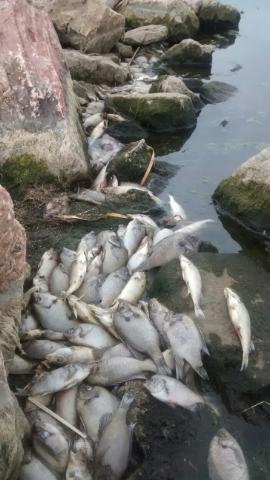Fish Kills
Winterkill and summer kill of fish is common in the shallow, highly productive prairie lakes of eastern South Dakota, although fish kills can occur in any water in the state. Most often, fish die due to a lack of oxygen in the water (dissolved oxygen), however, this is not always the case.
Winterkill
Most severe fish kills occur during the winter. Deep snow atop thick ice prevents the penetration of light into the water, needed for plants and microscopic plankton to photosynthesize and produce oxygen. Living organisms and dead and decaying plants and animals remove oxygen from the water faster than it can be replenished through photosynthesis, leading to low dissolved oxygen concentrations. Although fish are cold-blooded animals, and consume less oxygen at colder water temperatures, prolonged exposure to very low concentrations of dissolved oxygen eventually results in suffocation and death. Large-bodied fish like common carp and bigmouth buffalo are often found floating on the surface when the ice goes out in spring, while smaller fish that have died may sink to the bottom or are readily eaten by birds and often are not observed.
_Oakwood_winterkill_2019_2.jpg)
A less common form of winterkill occurs when excessive dissolved gas in the water, particularly nitrogen, causes what is termed “gas bubble disease”. A mild winter with little snow allows for ample light penetration and high photosynthetic activity under clear ice, which can produce excessive gas that cannot escape into the atmosphere. Additionally, nitrogen trapped in the ice is released as nitrous oxide as the ice melts adding to a high dissolved gas concentration in the water. External signs of gas bubble disease include bubbles or blisters at or under the skin and bulging eyes. Hemorrhaging frequently occurs with chronic gas bubble disease.
Spring Fish Kill
The stressful conditions of a long winter can sometimes cause a significant kill of fish in the spring. This is most commonly observed in crappies which may appear lethargic right after the ice goes out. Spring fish kills may also be related to stress incurred during the spawning process. This has most often been observed in common carp; however, it may go undetected in other smaller-bodied fish. Spring fish kills are often specific to a single species and waterbody and typically kill only a portion of the fish in a population.
Summer Kill
 There are several types of spring or summer kill that commonly occur in South Dakota lakes. The most common type of summer kill typically occurs during hot, calm days in late summer. When nitrogen, an important nutrient for algae and plants becomes limited, blooms of blue-green algae (also called cyanobacteria) can become more abundant. The increase in cyanobacteria occurs because of blue-green algae’s ability to fix atmospheric nitrogen via specialized cells called heterocysts. In this way, cyanobacteria outcompete green algae, resulting in dense blooms that produce oxygen during the day, but at night during the absence of photosynthesis, consume oxygen due to respiration. The reduction in dissolved oxygen concentration at night can temporarily lead to conditions that are lethal to fish. Summer fish kills are often confined to small areas of a lake where algal concentrations are most dense. Decreasing day length and correspondingly longer nights may also be responsible, in part, for the fact that this type of kill almost always occurs from late-July through August.
There are several types of spring or summer kill that commonly occur in South Dakota lakes. The most common type of summer kill typically occurs during hot, calm days in late summer. When nitrogen, an important nutrient for algae and plants becomes limited, blooms of blue-green algae (also called cyanobacteria) can become more abundant. The increase in cyanobacteria occurs because of blue-green algae’s ability to fix atmospheric nitrogen via specialized cells called heterocysts. In this way, cyanobacteria outcompete green algae, resulting in dense blooms that produce oxygen during the day, but at night during the absence of photosynthesis, consume oxygen due to respiration. The reduction in dissolved oxygen concentration at night can temporarily lead to conditions that are lethal to fish. Summer fish kills are often confined to small areas of a lake where algal concentrations are most dense. Decreasing day length and correspondingly longer nights may also be responsible, in part, for the fact that this type of kill almost always occurs from late-July through August.
The second type of summer fish kill most commonly occurs in small impoundments, private ponds, and some of our deepest lakes. As the water warms in the spring, the water column stratifies into separate layers with the warmer, less-dense water at the top (epilimnion), the colder, more-dense water at the bottom (hypolimnion) and a transition layer in between (thermocline). Wind mixes the water column and prevents this long-term stratification in most of our large, shallower natural lakes. However, in stratified lakes, oxygen is consumed faster than it can be replaced in the cold bottom layer of water so that by early to mid-summer, it contains little to no oxygen. Anaerobic bacteria that break down organic matter, like decaying plants and dead animals, in the absence of oxygen, result in the release of hydrogen sulfide which is toxic to fish and other aquatic animals. A rapid drop in air temperature (cold snap) or cold rainwater in heavy late-summer heavy rains can decrease the water temperature in the epilimnion to a point where the whole water column mixes. If the low-oxygen layer is large enough, the mixing of oxygenated and oxygen-deficient water can cause oxygen in the entire water column to decline, killing fish. These conditions typically only kill a portion of the fish community; however, every scenario is different.
_Scheffel_2020_FK_2.jpg)
Rebuilding Fisheries After a Kill
While the sight of dead fish and the thought of a loss of a fishery often result in negative feelings toward fish kills, that is not always the case. Often, the “clean” or uninhabited water after a severe winterkill provides an excellent opportunity to rebuild a fish community by stocking fish. Survival and growth of hatchery-reared fry and small fingerlings (such as walleye or northern pike) is excellent in the absence of predators and competitors for food. Game, Fish and Parks (GFP) will often capture pre-spawn panfish like yellow perch, crappies and bluegills from other public waters and stock them into the recently killed water where they can spawn and produce abundant offspring. As with the stockings of hatchery fish, these young fish survive and grow well without predators and competitors. Typically, with less severe summer and winterkills, the remaining fish community will rebuild populations through their own natural reproduction.
Contact Us
While GFP will not remove fish following a fish kill, we do record the event and information related to the species and number of fish involved. If you observe a fish kill, please contact your local Area Fisheries Supervisor.

